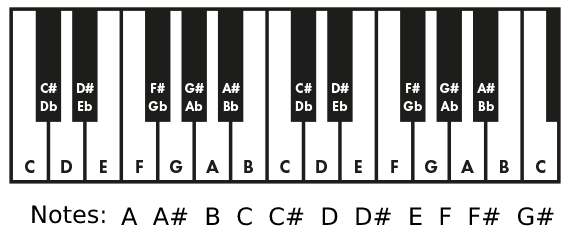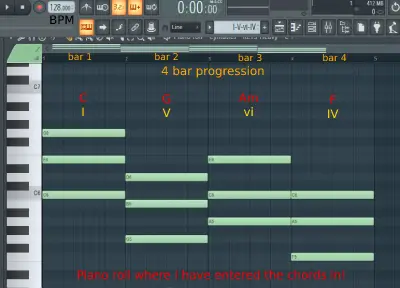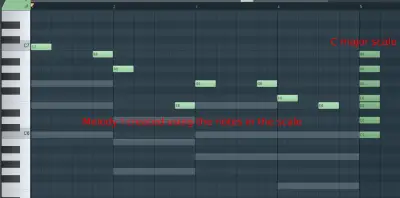Thinking about making music but think you need a ton of theory to start? Are you already creating songs but want to know what theory you should start with to get to the next level? Well, in this article I will go over the basic theory you need to understand how to create music!
Basic music theory to create music is knowing the notes used in music and how they relate to the key of a song. Learning the major and minor chords and scales is fundamental to musical theory.
This article will go through learning the notes used in music, how to select a key for a song and how to use that knowledge to create your own chord progressions, bassline, and melodies!
Pick A Key For The Song
You may be thinking, wait, why do I need to pick a key for my song when I don’t even know music theory? Well, choosing the key of your song will make every other aspect of creating a song much easier, from choosing chords, basslines, and even creating melodies.
First, there are 12 notes in (western) music: A, A#, B, C, C#, D, D#, E, F, F#, G, G#.
Each note will have a major or minor chord tonality that corresponds to it!
So, to choose the key of the song you’re going to create select a note and then decide if you want it major or minor.
For this example, I’m going to choose C major (C).

How To Choose Chords That Fit In A Key
Now that we have the key of our song (we’re using C major in this example) the next thing to do is to select a chord progression.
First, we need to know the chords that fit in the key of our song. Each key has 7 chords associated with it before the chords repeat themselves.
The song we chose to make for this example is in the key of C major so the chords we’re going to be working with are: C Dm Em F G Am Bdim (I have a chart below if you chose another key). We could choose any of these chords with our first chord being C, but there are common chord progressions that we can also choose from.
Most songs use four chords for their progression, so we’ll use the common chord progression: I – V – vi – IV.
Since we’re using the key of C for our example, our chord progression will be: C – G – Am – F.

The chords are represented by a roman numeral digit so the chord progression can be described without knowing the key of the song. The numbers reference what chord is being used in the progression, so in our song, we’ll use the:
- I – C major
- V – G major
- vi – A minor
- IV – F major
The upper case roman numeral signifies a major chord while a lower case roman numeral signifies a minor chord.
Common Chord Progressions – With Examples!
| Progression | Examples in C |
| I – V – vi – IV | C – G – Am – F |
| I – IV – V | C – C – F – G |
| I – vi – IV – V | C – Am – F – G |
| I – IV – vi – V | C – F – Am – G |
Reference For Major Chord Progressions
The chord pattern for a major key is: Major Minor Minor Major Major Minor Diminished.
The chord pattern for a natural minor key is: Minor Diminished Major Minor Minor Major Major.
Note: There are three minor variations: natural, melodic and harmonic minor.
| Major Key | I | ii | iii | IV | V | vi | VI |
| A | A | Bm | C#m | D | E | Fm# | G#dim |
| Bb (A#) | Bb | Cm | Dm | Eb | F | Gm | Adim |
| B | B | C#m | D#m | E | F# | G#m | A#dim |
| C | C | Dm | Em | F | G | Am | Bdim |
| Db (C#) | Db | Ebm | Fm | Gb | Ab | Bbm | Cdim |
| D | D | Em | F#m | G | A | Bm | C#dim |
| Eb (D#) | Eb | Fm | Gm | Ab | Bb | Cm | Ddim |
| E | E | F#m | G#m | A | B | C#m | D#dim |
| F | F | Gm | Am | Bb | C | Dm | Edim |
| Gb (F#) | Gb | Abm | Bbm | Cb | Db | Ebm | Fdim |
| G | G | Am | Bm | C | D | Em | F#dim |
| Ab (G#) | Ab | Bbm | Cm | Db | Eb | Fm | Gdim |
For more chord information check out Piano Keyboard Guide, they have so much information broken down to easy to read and understand articles! it’s my go-to place for any theory that I can glace at and implement; but also a great learning resource!
Selecting A Tempo For A Song
The tempo of a song dictates how fast or slow the song will be. The tempo of a song can change the feel of a song and many genres will typically fall into a specific tempo range. Tempo is described as beats per minute (BPM).
| Genre | BPM Range |
| Lofi | 60 to 86 |
| Trap | 70 to 80 |
| Hip-hop | 85 to 95 |
| Trip/Glitch Hop | 105 to 115 |
| House | 115 to 130 |
| Electro | 128 to 136 |
| Dubstep | 140 to 150 |
| Drum and Bass | 174 to 184 |
| Pop | 100 to 130 |
| Jazz and Funk | 120 to 125 |
| Rock | 110 to 140 |
| Metal | 100 to 160 |
Simple Method To Create Melodies
The simplest way to start creating melodies is to use notes from the scale in the key of your song. That means if your song is in the key of F major use the notes in the F major scale.

Resource to learn the major scale and minor scale.
Creating melodies is easy, creating a good melody is hard! The simplest way to get started is to use the notes in the key of the song you are in.
A method I use for finding what key I am in is to take the first chord in the chord progression, typically that is the key you are in! So, in our C major progression we are using (C – G – Am – F), just knowing the first chord is C is enough to assume the song is in the key of C.
This doesn’t work all the time but should work most of the time!
How To Create A Simple Bassline
To create a simple bassline use the root note of the chord being played for the bass note. For example, if the chord being played is C (major or minor, it doesn’t matter) the root note is C!
For our example chord progression we were the chords: C – G – Am – F.
Which means our bassline would be: C – G – A – F.
Summary
Learning basic music theory will help your music journey by allowing you to create chord progressions and melodies quickly and effectively. It’ll open up so many possibilities and help you create the song you hear in your head.
Knowing the key of a song will allow you to create your own chord progressions and melody much quicker and help you understand what melodies or chords you can use other people’s progressions or melodies!
Remember that learning chord progressions and scales are one part of the equation. Learning how to use them to create new and interesting songs is another! Take your time to learn and then let loose and experiment!
Don’t overthink it, don’t compare yourself to other’s progression, and most of all, remember these are just guidelines! Have fun with it!

1 thought on “Basic Theory To Start Creating Music”
Comments are closed.